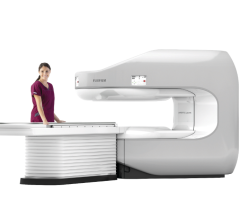
Greg Freiherr has reported on developments in radiology since 1983. He runs the consulting service, The Freiherr Group.
What Precision Means To PET

PET images taken on Philips’ Vereos PET/CT at Methodist Hospital in Omaha, Neb., show a lung lesion. Caveat: Because results may vary, “results from case studies are not predictive of results in other cases,” Philips cautioned. Images courtesy of Omaha’s Methodist Hospital
Precision can have an enormous impact on patients.
From diagnosis to patient monitoring (see “How Digital PET/CT Can Improve Clinical Care”), from the selection of therapy to its assessment (see “Digital PET Balances Scan Time and Resolution”), the digital detector built into Philips Vereos PET/CT makes positron imaging precise. (See “Why - And How - Digital PET Is Better Than Analog.”)
The digital detector, and the Vereos digital architecture, are a big part of the scanner’s efficiency, said Tom Brennan, service leader of Imaging for Nebraska Methodist Health Systems in Omaha, Neb. Staff at its Methodist Hospital in midtown Omaha use Vereos PET/CT to do seven PET scans a day — and about 20 CTs. Slots for PET patients are scheduled in pairs. In between, Vereos’ 64-slice CT handles patients who can’t be seen on the three CT scanners on the main campus or a fourth at a neighboring hospital in the network.
The need to do double duty on the hybrid scanner is why speed was a big factor in the choice of Vereos, said Brennan: “Because we share the system with CT, we have a lot of patients who want to get in, so we have to use (Vereos) efficiently.”
Because Vereos includes a 64-slice Ingenuity CT from Philips, “anything you can do with an Ingenuity CT you can do with the Vereos CT,” said Karim Boussebaa, Philips’ business leader for CT/Advanced Molecular Imaging.
Efficiency
Vereos was chosen by Methodist Hospital to replace an aging analog system, one that also handled overflow CT scans “but didn’t do nearly as well,” Brennan said. The analog system “was much slower and less reliable.”
Brennan credits the digital architecture of Vereos for making “it a more reliable system.”
Equipped as it is with time-of-flight and digital imaging, Vereos provides a leap forward in clinical performance, he said. Improved diagnostic performance is buoyed by the hybrid scanner’s efficiency as the scanner is routinely applied to serve two types of patients — those who need just CT and others who need positron imaging.
The vast majority of PET scans are oncologic, according to Brennan, who explains that the main campus hosts a major cancer center. Fluorine-18 deoxyglucose (FDG) is the radiotracer of choice, although gallium 68 is occasionally applied to visualize neuroendocrine tumors and yttrium-90 is used to treat and visualize liver metastases. The staff sometimes — but rarely — performs a myocardial viability study, Brennan noted.
Vereos’ digital technology can be leveraged to reduce radiopharmaceutical dosing. At Methodist Hospital in Omaha, staff inject lower doses of PET radiopharmaceuticals than when they used Vereos’ analog predecessor. Doses of FDG now are typically 30 percent lower than ones administered to patients before the hospital switched from an analog PET/CT to Vereos in early summer, according to Brennan. This has allowed the hospital to take advantage of the lower pricing tier of FDG that is available to Methodist Hospital.
“We went from a weight-based dosing system to one of standardized doses of just 12 mCi,” Brennan said. “What that did for us it dropped all of our doses into that lower price tier, which saves us about $25,000 per year.”
High efficiency is possible with no compromise in image quality because of the one-to-one coupling between sensor and scintillation event. “Each of the 23,000 detectors has its own little counting chip, which I think leads to the amazing spatial resolution,” Brennan said. “That goes back to the heart of why it is fast and why the image quality is so good.”
Efficiency may be further boosted on the CT side through workflow improvements achieved using Philips’ iPatient software. In a study involving multiphasic liver CT exams, iPatient reduced time-to-results by 24 percent and clicks per exam by 66 percent. [The study was performed by Nicholas Ardley (Southern Health) and Kevin Buchan and Ekta Dharaiya (Philips Healthcare).]
At Omaha’s Methodist Hospital PET, scan times have dropped from 24 to 12 minutes on the Vereos compared to the preceding analog system, according to Brennan. Patient slots have been reduced from 45 to 30 minutes. This has resulted in greater availability of PET and CT exams.
“Even though we use the same prep time, we have added seven (CT) patient slots,” he said.
The increased efficiency achieved with Vereos means Methodist Hospital patients not only spend less time being scanned but less time waiting for appointments. This is important because “three out of our four patients are return patients. Vereos is the preferred tool to measure how treatments are going,” Brennan said.
Staying on schedule is very important for these patients, he said, because they typically depend on having results from multiple tests available at the same time: “So access is important. The speed of Vereos has helped us become better at getting patients in on time.”
Extending Patient Comfort
Patient comfort depends on feeling good. And Philips’ Ambient Experience directly addresses this in several modalities including CT and PET. “Ambient has shown some good results for reducing the level of stress,” said Philips executive Boussebaa. “It can really make a difference with kids.”
A mix of lighting and sound — movies projected on walls, for example — might combine to reduce stress, he said. These combinations can increase patient satisfaction, which has become a major survey item for hospitals.
Greater patient comfort can make patients easier to manage, which can make technologists’ jobs easier. In this way, Philips’ Ambient Experience improves working conditions for staff.
“The question is how to make people happy,” he said. “If you do that, patients will come back and staff will stay.”
According to Boussebaa, health care administrators are coming to realize that patient comfort has a role in being efficient and effective.
With its emphasis on precision, Vereos addresses patient comfort, the components of value-based medicine — and the future.
Editor's note: This is the fourth blog in a series of five on digital PET/CT. The first blog, “How Digital PET/CT Can Improve Clinical Care,” can be found here. The second blog, “Why - And How - Digital PET Is Better Than Analog,” can be found here. The third blog, “Digital PET Balances Scan Time and Resolution,” can be found here.
Related Content:



 July 30, 2024
July 30, 2024 








